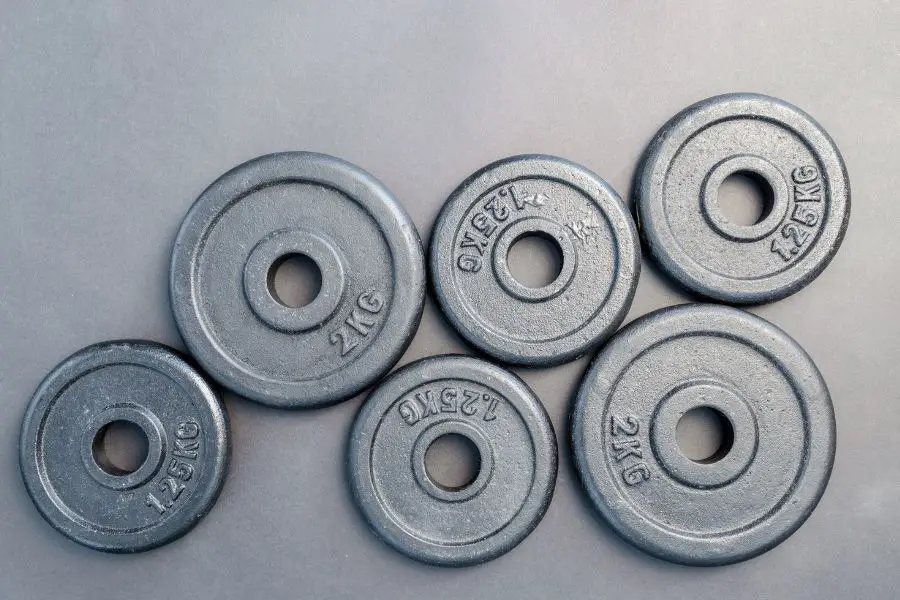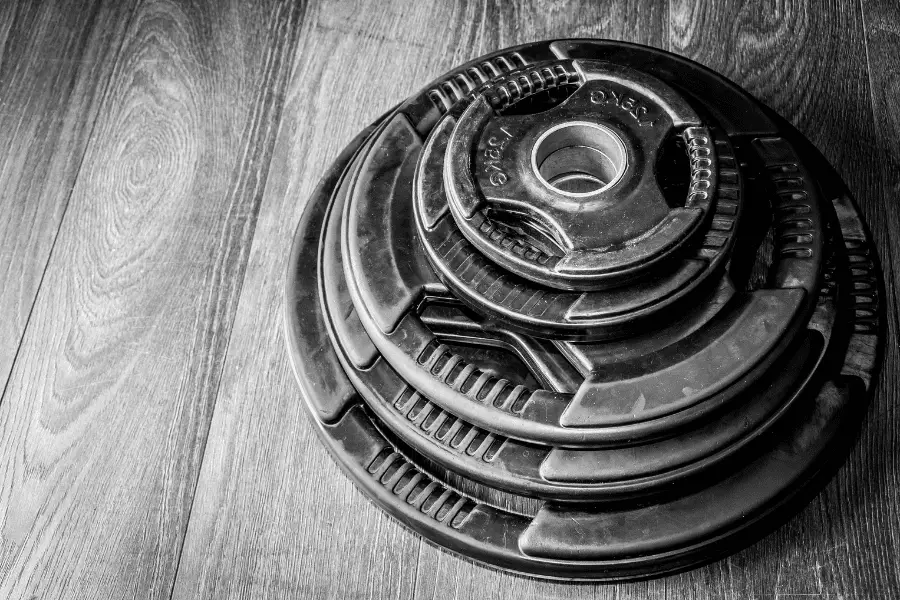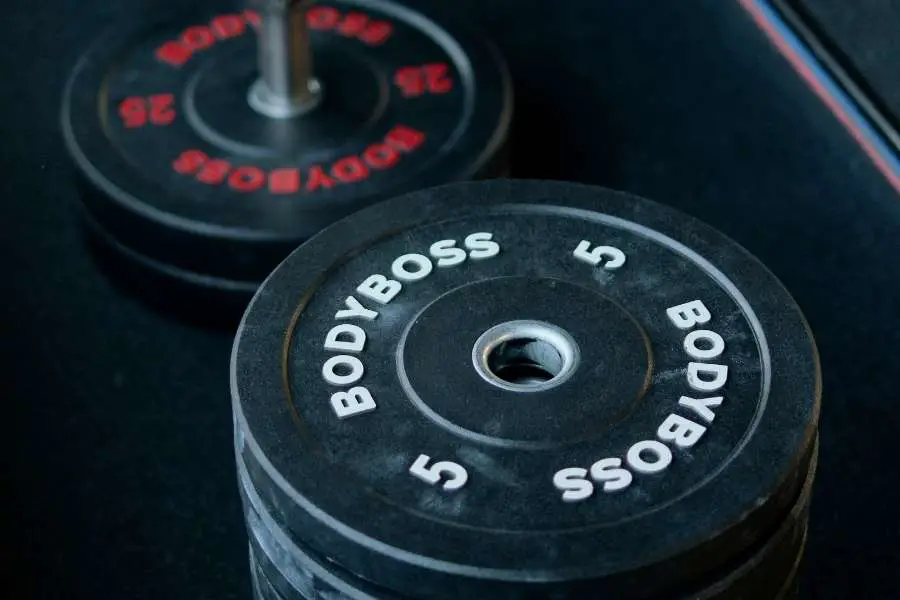Weight plates are a key component of any gym but you might not know there are two different types. There are Olympic and Standard weight plates. What are the differences and which type should you pick? Here’s what you should know.
Standard weight plates have a 1″/25 mm inner hole while Olympic plates have a 2″/50 mm hole. In general, Olympic plates are the better choice and therefore more popular. While Standard plates are OK for home gyms and general fitness, for more serious lifting Olympic plates and barbells are a must have.
There are some other pros and cons for each type of plate and also the related equipment you’ll have to get to use them. Let’s dive into the differences and what’s best for your situation.
Contents
What are Standard Weight Plates?

Standard weight plates have a 1″ diameter hole and are commonly used for various types of weightlifting equipment, such as barbells and some adjustable dumbbells.
These plates are often referred to as “standard” or “1-inch” plates. The most common sizes for standard weight plates include:
These plates are typically made from cast iron and are designed to fit on bars with a 1″ diameter. They can look different ways but if they’ve got the 1″/25mm hole, they’re standard plates.
What are Olympic Weight Plates?

Olympic weight plates with a 2″/50mm diameter hole are designed for use with Olympic-sized barbells, which have thicker sleeves compared to standard barbells. These plates are commonly used in commercial gyms, professional weightlifting, and powerlifting settings.
The most common sizes for Olympic weight plates include:
You don’t need all of those weights, read here how to make the perfect weight plate set.
Olympic weight plates are often made from cast iron, rubber-coated, or urethane-coated for added protection to the plate and floor. Some Olympic plates are made entirely out of rubber. These are also known as ‘bumper’ plates.
The larger hole diameter means they are not compatible with standard 1″ diameter bars. These plates are used in various types of weightlifting and strength training, including powerlifting, Olympic weightlifting, and general fitness.
You can find the best Olympic weight plates for your gym in this article.
Are Standard (1″) or Olympic (2″) Plates Better?
2″ Olympic weight plates and barbells are better for the majority of people. They allow for better technique, fewer injuries, are higher quality, and are more commonly available.
While the main difference between standard and Olympic plates is just the size of the hole, there are a few other factors surrounding the different types of plates.
That’s because you shouldn’t only look at the plates but also the barbells and equipment they go on. And since the hole size is different, the barbells have to be different too. And then suddenly you’re not only looking at a size difference but some other key differences as well.
| Standard vs. Olympic Plates | Standard (1″/25 mm) | Olympic (2″/50 mm) | |
| Spinning sleeves | |||
| Bumper plates | |||
| Quality | |||
| Load Capacity | |||
| Price | |||
| Choices/Availability |
As you can see from the chart above, the only reason to choose standard plates is price and the difference is not that big if you look at the price of a whole home gym setup.
If you’ve already got some standard equipment, you don’t have to upgrade if you’re happy, but know that Olympic bars and plates are a little better.
You can find the best Olympic garage gym barbells in this article.
1. Spinning Sleeves
The main feature why you want 2” Olympic plates is because you want the ends of the barbell to spin. With 1” standard plates, there is no space for the bearing and thus the barbell sleeves are fixed and the plates rotate with the bar.
Olympic barbells have spinning sleeves which means the plates don’t rotate when rotating the barbell. This has several benefits. The two main benefits are:
Because the bar rotates independently from the plates, spinning the bar doesn’t then put extra torque on your wrists and other joints. Spinning plates want to keep spinning and this twists your wrists and could even try to roll the bar out of your hands.
When you don’t have to worry about that, you can just focus on technique and form which helps you to lift more in the end. It also means you have a lower injury risk since your technique isn’t thrown off and you can focus more on the lift.
2. Bumper Plates
Both standard and Olympic plates are usually made from cast iron. They can have grip holes and a rubber casing but the core is cast iron.
However, Olympic plates have a subtype called ‘bumper plates’. These are the plates you see when watching the Olympic Games. Bumper plates are made completely from rubber instead of cast iron. Only the insert around the hole is usually metal.
These rubber plates are made to be dropped on the floor from overhead without breaking. Cast iron plates can’t handle this.
So, 2” bars and plates are the way to go if you want to use bumper plates.

3. Quality
When comparing the quality of 1” and 2” plates, you’re usually getting pretty much the same thing when looking in the same price range.
However, standard weight plates are often very basic. Cast iron without grip holes is no exception. Olympic plates often have grip holes and are encased in rubber. Olympic plates are just a little nicer and higher-quality in general.
And yes, you do pay a little extra for Olympic plates in general but you can find good deals and you get something nicer.
Don’t forget the barbells. Standard barbells are usually really cheap products. Both in price and build quality. They don’t feel as good as Olympic barbells and usually can’t handle as much weight.
4. Max Load Capacity
While the weight plates weigh the same regardless of their type, the barbells are a bit different. Most standard barbells are quite cheap and thus cheaply made. They can often only handle up to about 250-300 lbs. in load before they start complaining (potentially bending).
That’s not quite enough for many enthusiastic lifters. Especially on the deadlift, it’s not that hard to lift more than 250 lbs. So if you’re planning to lift heavy, 2” plates and bars are the better choice.
A half-decent Olympic barbell can handle at least 500 lbs. and a good one 800 lbs.+
5. Price
Standard weight plates can be a little bit cheaper than Olympic plates but the difference isn’t big and you’re usually getting a nicer plate for that extra money.
The price difference is mainly in the barbell. 1″ barbells are much cheaper than Olympic barbells. That’s because they’re much simpler. Standard barbells don’t have spinning sleeves and are just metal bars. Olympic barbells are more complicated and so more expensive.
However, once again, you get something that’s usually quite a bit nicer and better for the extra money you pay.
6. Choices
Going for an Olympic setup gives you way more choices in both plates and barbells. Not only is the quality of Olympic-style products higher, there are just more options.
That’s because 2” setups have been the standard for a while. Only if you really want to save every last cent is it advisable to use a 1” setup, otherwise the drawbacks aren’t worth it.
Who Needs Olympic Plates?
So Olympic plates have some benefits over standard plates but do you really need them?
For people that want to focus on general fitness, standard plates are OK. Yeah, they have some downsides but the main one, the lack of spinning sleeves is not as big a deal when you move the bar slowly.
I still think 2” bars and plates are the better choice if you still have to buy all your equipment. But, if you have a 1” bar or 1” plates and need the other part, it’s OK to get 1” plates or a bar to save some money.
Just want good future-proof gym equipment? 2″ Olympic plates, bars and equipment are just superior to standard ones.
People that do Olympic lifts like the clean & jerk and the snatch, you absolutely need 2” Olympic bars and plates. To get good form on those lifts, you have to rotate the bar very quickly. That’s impossible with standard plates on a standard bar.

Do Standard Plates Fit On Olympic Barbells?
Standard plates do not fit on Olympic barbells. The hole in the plates is simply too small to slide over the sleeve of an Olympic bar.
Olympic plates do fit on a standard barbell but only very loosely. This combo is not safe to use for any type of exercise since the plates slide off too easily. There are adapters to slide over 1″ barbells to take 2″ plates without too much play. However, those adapters won’t spin so you’ll still have all the drawbacks of 1″ plates.
| Standard Barbell/Pegs (1”/25mm Sleeve) | Olympic Barbell/Pegs (2”/50mm Sleeves) | |
| Standard Plates (1”/25mm hole) | Fits | Doesn’t Fit |
| Olympic Plates (2”/50mm Sleeves) | Only Fits With Adapter | Fits |


